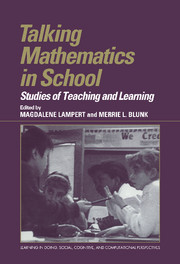1 - Introduction
Published online by Cambridge University Press: 04 August 2010
Summary
Consider the collection of regularly shaped flat blocks shown in Figure 1.1. Can two of them be joined to make a hexagon? What is a hexagon anyway? And what does it mean to “join” two of these pieces?
A Sample of Mathematical Talk in School
To introduce the ideas in this volume, I begin with an extended example of mathematical talk from my fifth-grade classroom. This talk will not be analyzed here but will serve to raise the central ideas in the chapters in this book. What does mathematical talk have to do with learning? How do students learn to discuss mathematics? What do the words they use refer to? What does a teacher do in a mathematical discussion? What does classroom discussion have to do with the way mathematical problem solving proceeds outside the classroom?
My fifth-grade students – in groups of four or five – worked with sets of blocks like the ones pictured in Figure 1.1 (called tangrams) to find out if two of them could make a hexagon. And they talked about what they were doing. They disagreed about the “rules of the game”: Can “join” mean “overlap”? Can you turn the blocks over? Does “two” mean two of the same shape or two different ones? Does a hexagon have to have equal sides? I did not answer these questions or resolve their disagreements.
- Type
- Chapter
- Information
- Talking Mathematics in SchoolStudies of Teaching and Learning, pp. 1 - 14Publisher: Cambridge University PressPrint publication year: 1998
- 1
- Cited by



